LOOG5026 Logistics & Operations in Oil & Gas: Saudi Aramco & ADNOC
VerifiedAdded on 2023/05/30
|12
|3619
|113
Case Study
AI Summary
This case study examines the logistics and operations of Saudi Aramco and ADNOC, focusing on challenges in new markets like India. It identifies key issues such as cost control, workforce management, cultural integration, asset management, and corporate social responsibility. The analysis includes a comparison with competitors like Indian Oil, highlighting their strengths and weaknesses in safety, employee experience, inspection, and spill control. The study also addresses the economic and environmental impacts of operations, along with human behavioral considerations, and concludes with recommendations for Saudi Aramco to succeed in the competitive Indian market. Desklib provides access to similar case studies and solved assignments for students.
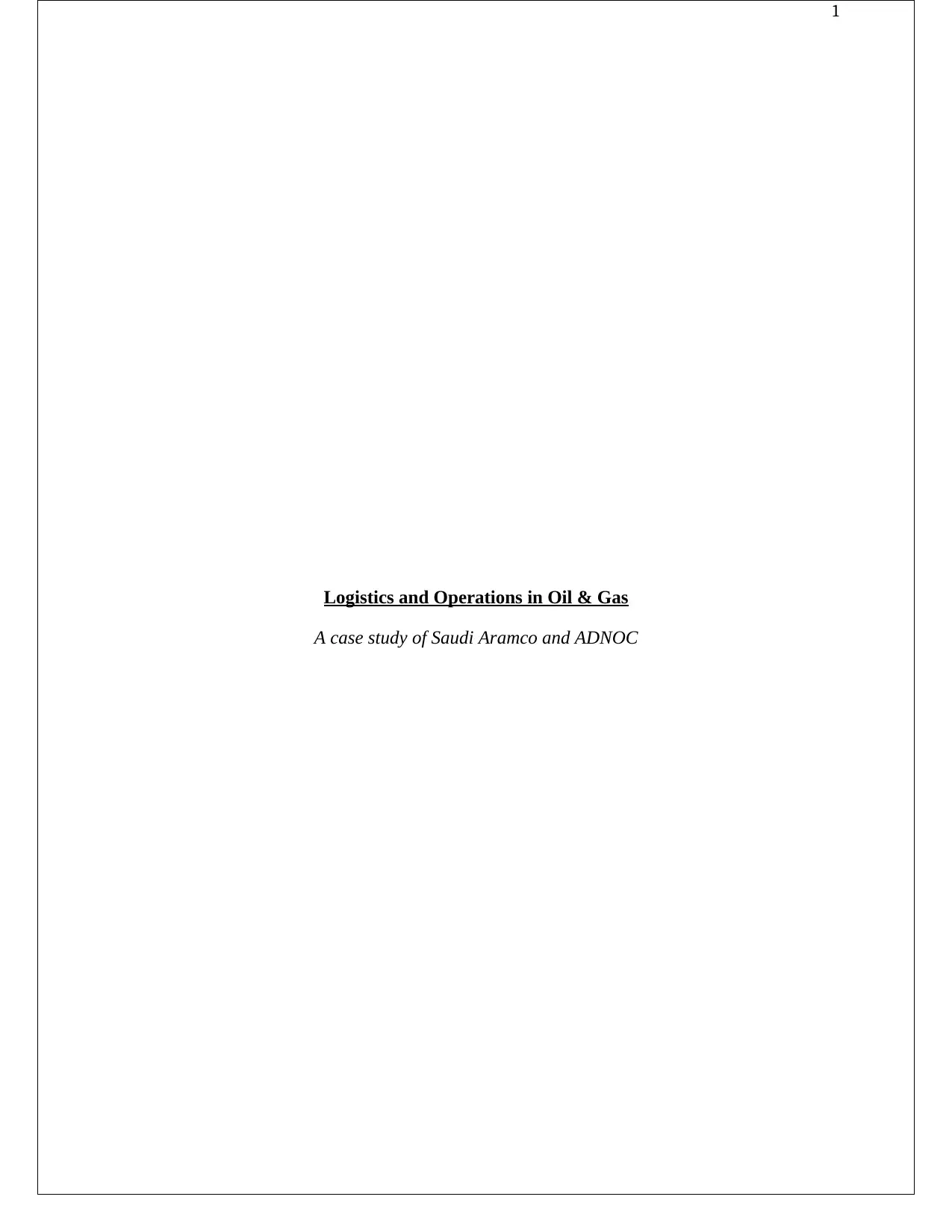
1
Logistics and Operations in Oil & Gas
A case study of Saudi Aramco and ADNOC
Logistics and Operations in Oil & Gas
A case study of Saudi Aramco and ADNOC
Paraphrase This Document
Need a fresh take? Get an instant paraphrase of this document with our AI Paraphraser
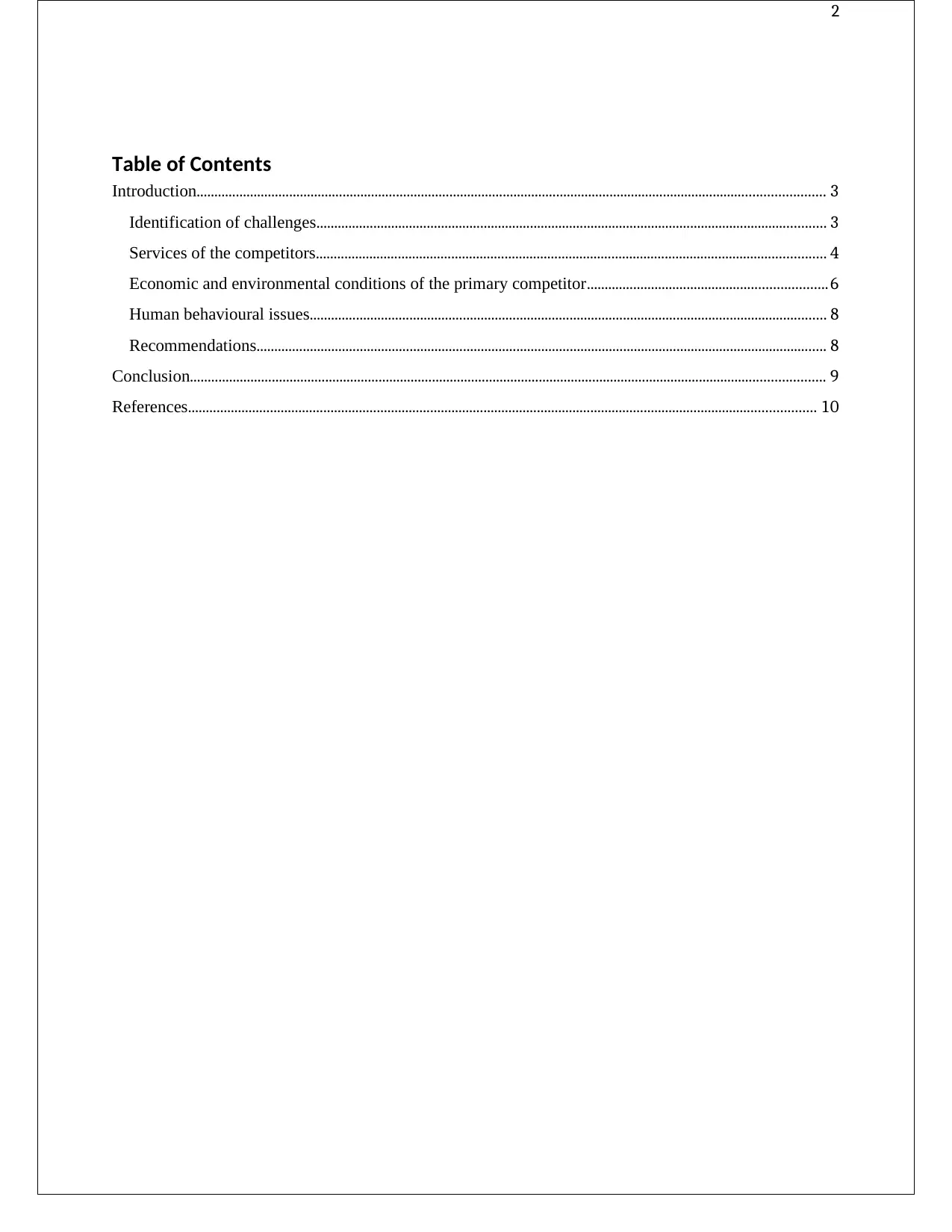
2
Table of Contents
Introduction................................................................................................................................................................................ 3
Identification of challenges............................................................................................................................................... 3
Services of the competitors............................................................................................................................................... 4
Economic and environmental conditions of the primary competitor...................................................................6
Human behavioural issues................................................................................................................................................. 8
Recommendations................................................................................................................................................................ 8
Conclusion.................................................................................................................................................................................. 9
References................................................................................................................................................................................ 10
Table of Contents
Introduction................................................................................................................................................................................ 3
Identification of challenges............................................................................................................................................... 3
Services of the competitors............................................................................................................................................... 4
Economic and environmental conditions of the primary competitor...................................................................6
Human behavioural issues................................................................................................................................................. 8
Recommendations................................................................................................................................................................ 8
Conclusion.................................................................................................................................................................................. 9
References................................................................................................................................................................................ 10
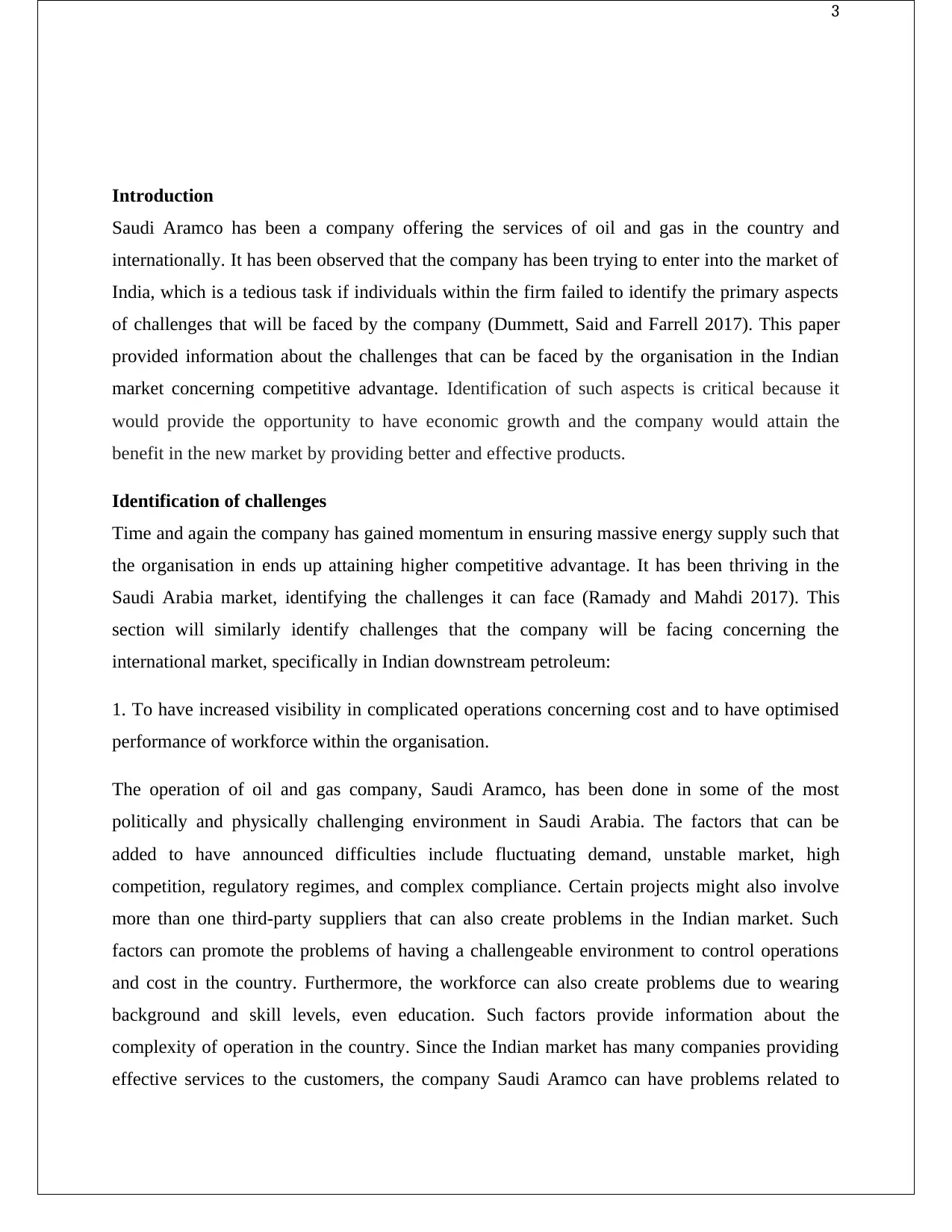
3
Introduction
Saudi Aramco has been a company offering the services of oil and gas in the country and
internationally. It has been observed that the company has been trying to enter into the market of
India, which is a tedious task if individuals within the firm failed to identify the primary aspects
of challenges that will be faced by the company (Dummett, Said and Farrell 2017). This paper
provided information about the challenges that can be faced by the organisation in the Indian
market concerning competitive advantage. Identification of such aspects is critical because it
would provide the opportunity to have economic growth and the company would attain the
benefit in the new market by providing better and effective products.
Identification of challenges
Time and again the company has gained momentum in ensuring massive energy supply such that
the organisation in ends up attaining higher competitive advantage. It has been thriving in the
Saudi Arabia market, identifying the challenges it can face (Ramady and Mahdi 2017). This
section will similarly identify challenges that the company will be facing concerning the
international market, specifically in Indian downstream petroleum:
1. To have increased visibility in complicated operations concerning cost and to have optimised
performance of workforce within the organisation.
The operation of oil and gas company, Saudi Aramco, has been done in some of the most
politically and physically challenging environment in Saudi Arabia. The factors that can be
added to have announced difficulties include fluctuating demand, unstable market, high
competition, regulatory regimes, and complex compliance. Certain projects might also involve
more than one third-party suppliers that can also create problems in the Indian market. Such
factors can promote the problems of having a challengeable environment to control operations
and cost in the country. Furthermore, the workforce can also create problems due to wearing
background and skill levels, even education. Such factors provide information about the
complexity of operation in the country. Since the Indian market has many companies providing
effective services to the customers, the company Saudi Aramco can have problems related to
Introduction
Saudi Aramco has been a company offering the services of oil and gas in the country and
internationally. It has been observed that the company has been trying to enter into the market of
India, which is a tedious task if individuals within the firm failed to identify the primary aspects
of challenges that will be faced by the company (Dummett, Said and Farrell 2017). This paper
provided information about the challenges that can be faced by the organisation in the Indian
market concerning competitive advantage. Identification of such aspects is critical because it
would provide the opportunity to have economic growth and the company would attain the
benefit in the new market by providing better and effective products.
Identification of challenges
Time and again the company has gained momentum in ensuring massive energy supply such that
the organisation in ends up attaining higher competitive advantage. It has been thriving in the
Saudi Arabia market, identifying the challenges it can face (Ramady and Mahdi 2017). This
section will similarly identify challenges that the company will be facing concerning the
international market, specifically in Indian downstream petroleum:
1. To have increased visibility in complicated operations concerning cost and to have optimised
performance of workforce within the organisation.
The operation of oil and gas company, Saudi Aramco, has been done in some of the most
politically and physically challenging environment in Saudi Arabia. The factors that can be
added to have announced difficulties include fluctuating demand, unstable market, high
competition, regulatory regimes, and complex compliance. Certain projects might also involve
more than one third-party suppliers that can also create problems in the Indian market. Such
factors can promote the problems of having a challengeable environment to control operations
and cost in the country. Furthermore, the workforce can also create problems due to wearing
background and skill levels, even education. Such factors provide information about the
complexity of operation in the country. Since the Indian market has many companies providing
effective services to the customers, the company Saudi Aramco can have problems related to
⊘ This is a preview!⊘
Do you want full access?
Subscribe today to unlock all pages.

Trusted by 1+ million students worldwide
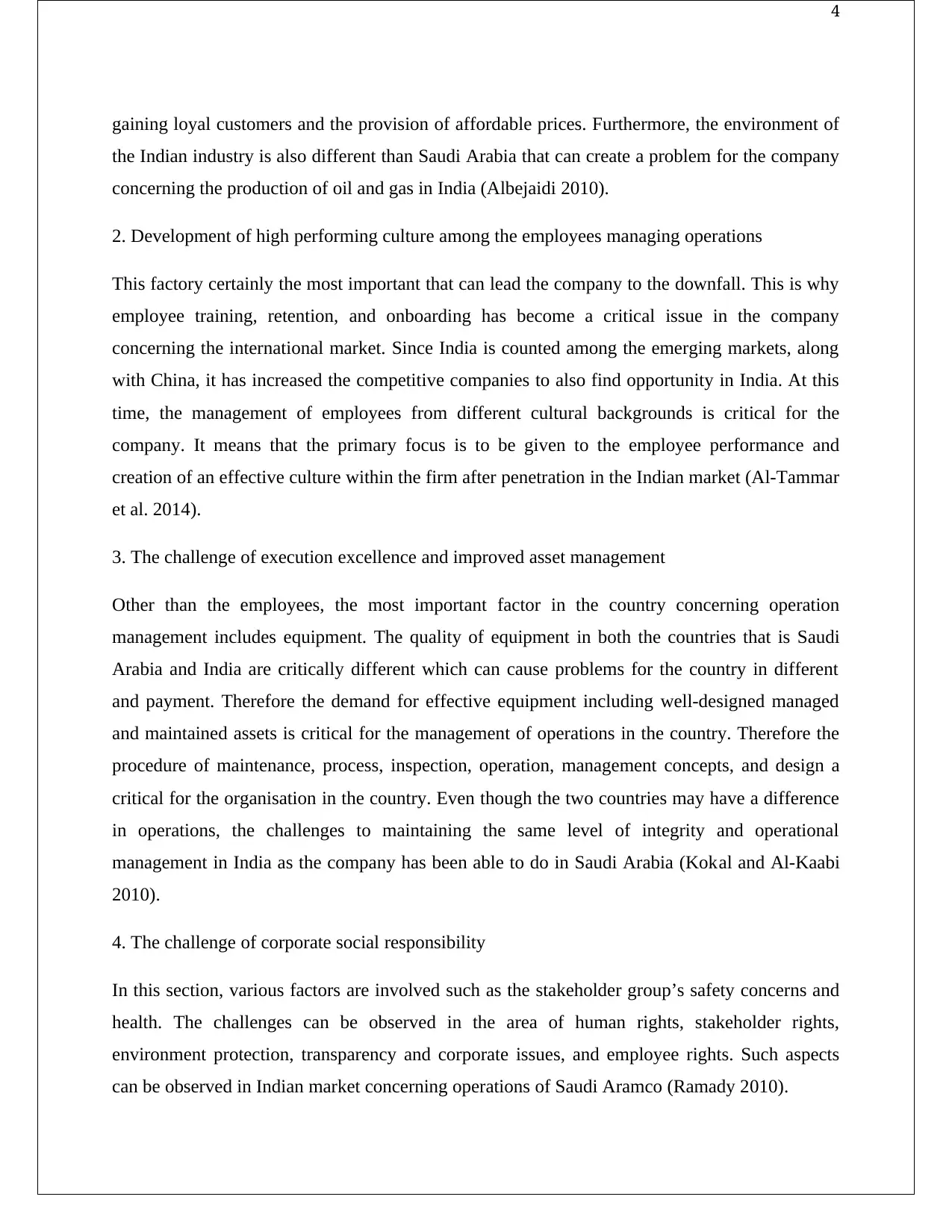
4
gaining loyal customers and the provision of affordable prices. Furthermore, the environment of
the Indian industry is also different than Saudi Arabia that can create a problem for the company
concerning the production of oil and gas in India (Albejaidi 2010).
2. Development of high performing culture among the employees managing operations
This factory certainly the most important that can lead the company to the downfall. This is why
employee training, retention, and onboarding has become a critical issue in the company
concerning the international market. Since India is counted among the emerging markets, along
with China, it has increased the competitive companies to also find opportunity in India. At this
time, the management of employees from different cultural backgrounds is critical for the
company. It means that the primary focus is to be given to the employee performance and
creation of an effective culture within the firm after penetration in the Indian market (Al-Tammar
et al. 2014).
3. The challenge of execution excellence and improved asset management
Other than the employees, the most important factor in the country concerning operation
management includes equipment. The quality of equipment in both the countries that is Saudi
Arabia and India are critically different which can cause problems for the country in different
and payment. Therefore the demand for effective equipment including well-designed managed
and maintained assets is critical for the management of operations in the country. Therefore the
procedure of maintenance, process, inspection, operation, management concepts, and design a
critical for the organisation in the country. Even though the two countries may have a difference
in operations, the challenges to maintaining the same level of integrity and operational
management in India as the company has been able to do in Saudi Arabia (Kokal and Al-Kaabi
2010).
4. The challenge of corporate social responsibility
In this section, various factors are involved such as the stakeholder group’s safety concerns and
health. The challenges can be observed in the area of human rights, stakeholder rights,
environment protection, transparency and corporate issues, and employee rights. Such aspects
can be observed in Indian market concerning operations of Saudi Aramco (Ramady 2010).
gaining loyal customers and the provision of affordable prices. Furthermore, the environment of
the Indian industry is also different than Saudi Arabia that can create a problem for the company
concerning the production of oil and gas in India (Albejaidi 2010).
2. Development of high performing culture among the employees managing operations
This factory certainly the most important that can lead the company to the downfall. This is why
employee training, retention, and onboarding has become a critical issue in the company
concerning the international market. Since India is counted among the emerging markets, along
with China, it has increased the competitive companies to also find opportunity in India. At this
time, the management of employees from different cultural backgrounds is critical for the
company. It means that the primary focus is to be given to the employee performance and
creation of an effective culture within the firm after penetration in the Indian market (Al-Tammar
et al. 2014).
3. The challenge of execution excellence and improved asset management
Other than the employees, the most important factor in the country concerning operation
management includes equipment. The quality of equipment in both the countries that is Saudi
Arabia and India are critically different which can cause problems for the country in different
and payment. Therefore the demand for effective equipment including well-designed managed
and maintained assets is critical for the management of operations in the country. Therefore the
procedure of maintenance, process, inspection, operation, management concepts, and design a
critical for the organisation in the country. Even though the two countries may have a difference
in operations, the challenges to maintaining the same level of integrity and operational
management in India as the company has been able to do in Saudi Arabia (Kokal and Al-Kaabi
2010).
4. The challenge of corporate social responsibility
In this section, various factors are involved such as the stakeholder group’s safety concerns and
health. The challenges can be observed in the area of human rights, stakeholder rights,
environment protection, transparency and corporate issues, and employee rights. Such aspects
can be observed in Indian market concerning operations of Saudi Aramco (Ramady 2010).
Paraphrase This Document
Need a fresh take? Get an instant paraphrase of this document with our AI Paraphraser
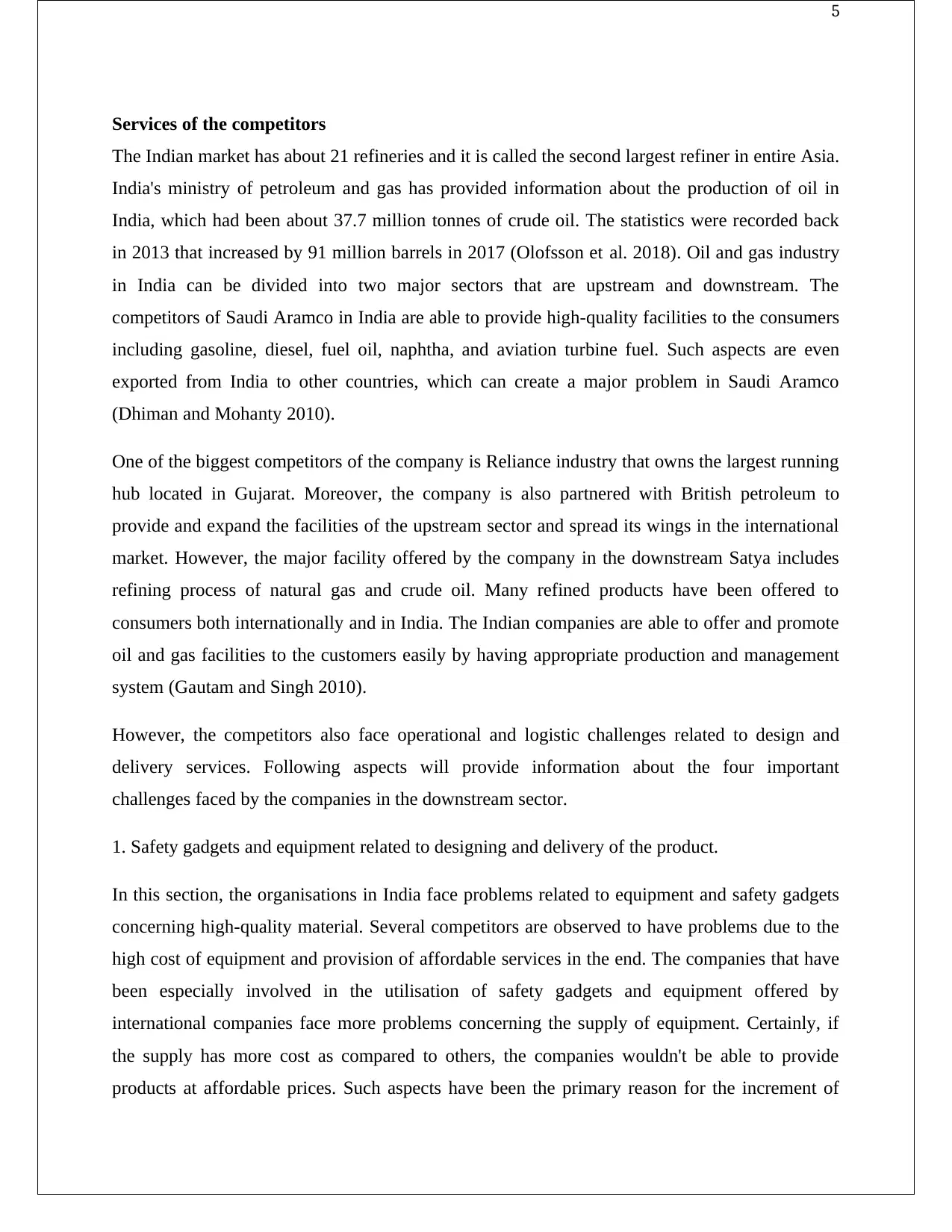
5
Services of the competitors
The Indian market has about 21 refineries and it is called the second largest refiner in entire Asia.
India's ministry of petroleum and gas has provided information about the production of oil in
India, which had been about 37.7 million tonnes of crude oil. The statistics were recorded back
in 2013 that increased by 91 million barrels in 2017 (Olofsson et al. 2018). Oil and gas industry
in India can be divided into two major sectors that are upstream and downstream. The
competitors of Saudi Aramco in India are able to provide high-quality facilities to the consumers
including gasoline, diesel, fuel oil, naphtha, and aviation turbine fuel. Such aspects are even
exported from India to other countries, which can create a major problem in Saudi Aramco
(Dhiman and Mohanty 2010).
One of the biggest competitors of the company is Reliance industry that owns the largest running
hub located in Gujarat. Moreover, the company is also partnered with British petroleum to
provide and expand the facilities of the upstream sector and spread its wings in the international
market. However, the major facility offered by the company in the downstream Satya includes
refining process of natural gas and crude oil. Many refined products have been offered to
consumers both internationally and in India. The Indian companies are able to offer and promote
oil and gas facilities to the customers easily by having appropriate production and management
system (Gautam and Singh 2010).
However, the competitors also face operational and logistic challenges related to design and
delivery services. Following aspects will provide information about the four important
challenges faced by the companies in the downstream sector.
1. Safety gadgets and equipment related to designing and delivery of the product.
In this section, the organisations in India face problems related to equipment and safety gadgets
concerning high-quality material. Several competitors are observed to have problems due to the
high cost of equipment and provision of affordable services in the end. The companies that have
been especially involved in the utilisation of safety gadgets and equipment offered by
international companies face more problems concerning the supply of equipment. Certainly, if
the supply has more cost as compared to others, the companies wouldn't be able to provide
products at affordable prices. Such aspects have been the primary reason for the increment of
Services of the competitors
The Indian market has about 21 refineries and it is called the second largest refiner in entire Asia.
India's ministry of petroleum and gas has provided information about the production of oil in
India, which had been about 37.7 million tonnes of crude oil. The statistics were recorded back
in 2013 that increased by 91 million barrels in 2017 (Olofsson et al. 2018). Oil and gas industry
in India can be divided into two major sectors that are upstream and downstream. The
competitors of Saudi Aramco in India are able to provide high-quality facilities to the consumers
including gasoline, diesel, fuel oil, naphtha, and aviation turbine fuel. Such aspects are even
exported from India to other countries, which can create a major problem in Saudi Aramco
(Dhiman and Mohanty 2010).
One of the biggest competitors of the company is Reliance industry that owns the largest running
hub located in Gujarat. Moreover, the company is also partnered with British petroleum to
provide and expand the facilities of the upstream sector and spread its wings in the international
market. However, the major facility offered by the company in the downstream Satya includes
refining process of natural gas and crude oil. Many refined products have been offered to
consumers both internationally and in India. The Indian companies are able to offer and promote
oil and gas facilities to the customers easily by having appropriate production and management
system (Gautam and Singh 2010).
However, the competitors also face operational and logistic challenges related to design and
delivery services. Following aspects will provide information about the four important
challenges faced by the companies in the downstream sector.
1. Safety gadgets and equipment related to designing and delivery of the product.
In this section, the organisations in India face problems related to equipment and safety gadgets
concerning high-quality material. Several competitors are observed to have problems due to the
high cost of equipment and provision of affordable services in the end. The companies that have
been especially involved in the utilisation of safety gadgets and equipment offered by
international companies face more problems concerning the supply of equipment. Certainly, if
the supply has more cost as compared to others, the companies wouldn't be able to provide
products at affordable prices. Such aspects have been the primary reason for the increment of
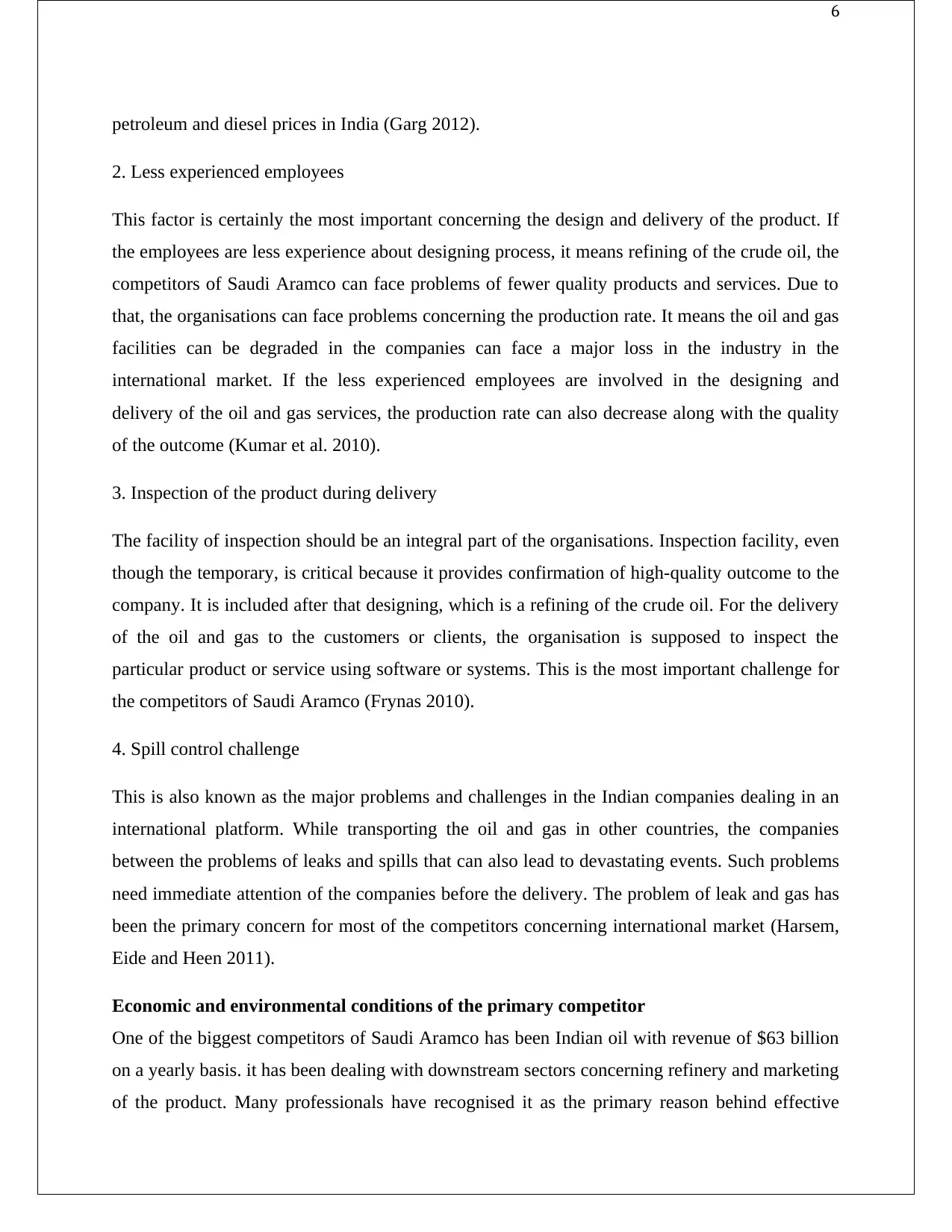
6
petroleum and diesel prices in India (Garg 2012).
2. Less experienced employees
This factor is certainly the most important concerning the design and delivery of the product. If
the employees are less experience about designing process, it means refining of the crude oil, the
competitors of Saudi Aramco can face problems of fewer quality products and services. Due to
that, the organisations can face problems concerning the production rate. It means the oil and gas
facilities can be degraded in the companies can face a major loss in the industry in the
international market. If the less experienced employees are involved in the designing and
delivery of the oil and gas services, the production rate can also decrease along with the quality
of the outcome (Kumar et al. 2010).
3. Inspection of the product during delivery
The facility of inspection should be an integral part of the organisations. Inspection facility, even
though the temporary, is critical because it provides confirmation of high-quality outcome to the
company. It is included after that designing, which is a refining of the crude oil. For the delivery
of the oil and gas to the customers or clients, the organisation is supposed to inspect the
particular product or service using software or systems. This is the most important challenge for
the competitors of Saudi Aramco (Frynas 2010).
4. Spill control challenge
This is also known as the major problems and challenges in the Indian companies dealing in an
international platform. While transporting the oil and gas in other countries, the companies
between the problems of leaks and spills that can also lead to devastating events. Such problems
need immediate attention of the companies before the delivery. The problem of leak and gas has
been the primary concern for most of the competitors concerning international market (Harsem,
Eide and Heen 2011).
Economic and environmental conditions of the primary competitor
One of the biggest competitors of Saudi Aramco has been Indian oil with revenue of $63 billion
on a yearly basis. it has been dealing with downstream sectors concerning refinery and marketing
of the product. Many professionals have recognised it as the primary reason behind effective
petroleum and diesel prices in India (Garg 2012).
2. Less experienced employees
This factor is certainly the most important concerning the design and delivery of the product. If
the employees are less experience about designing process, it means refining of the crude oil, the
competitors of Saudi Aramco can face problems of fewer quality products and services. Due to
that, the organisations can face problems concerning the production rate. It means the oil and gas
facilities can be degraded in the companies can face a major loss in the industry in the
international market. If the less experienced employees are involved in the designing and
delivery of the oil and gas services, the production rate can also decrease along with the quality
of the outcome (Kumar et al. 2010).
3. Inspection of the product during delivery
The facility of inspection should be an integral part of the organisations. Inspection facility, even
though the temporary, is critical because it provides confirmation of high-quality outcome to the
company. It is included after that designing, which is a refining of the crude oil. For the delivery
of the oil and gas to the customers or clients, the organisation is supposed to inspect the
particular product or service using software or systems. This is the most important challenge for
the competitors of Saudi Aramco (Frynas 2010).
4. Spill control challenge
This is also known as the major problems and challenges in the Indian companies dealing in an
international platform. While transporting the oil and gas in other countries, the companies
between the problems of leaks and spills that can also lead to devastating events. Such problems
need immediate attention of the companies before the delivery. The problem of leak and gas has
been the primary concern for most of the competitors concerning international market (Harsem,
Eide and Heen 2011).
Economic and environmental conditions of the primary competitor
One of the biggest competitors of Saudi Aramco has been Indian oil with revenue of $63 billion
on a yearly basis. it has been dealing with downstream sectors concerning refinery and marketing
of the product. Many professionals have recognised it as the primary reason behind effective
⊘ This is a preview!⊘
Do you want full access?
Subscribe today to unlock all pages.

Trusted by 1+ million students worldwide
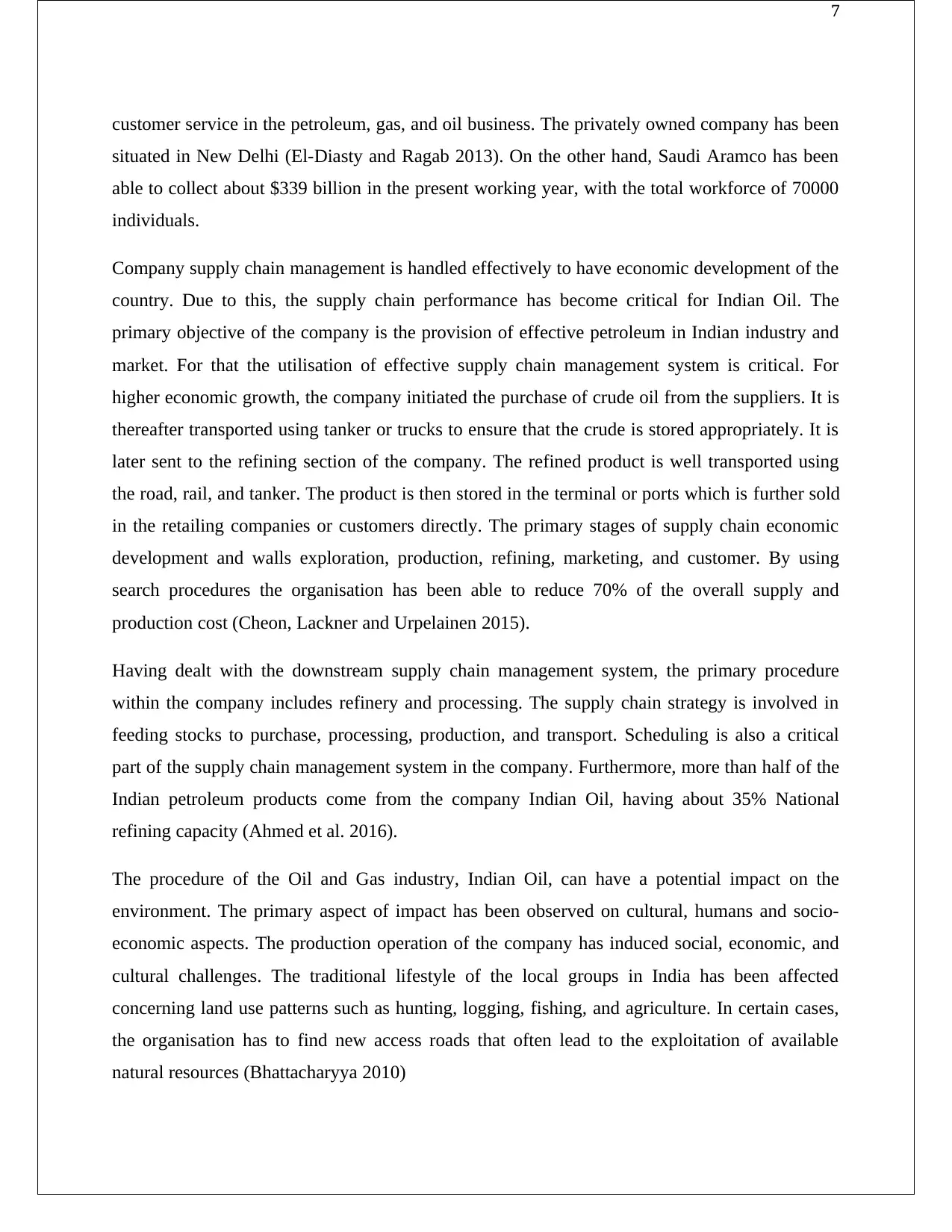
7
customer service in the petroleum, gas, and oil business. The privately owned company has been
situated in New Delhi (El-Diasty and Ragab 2013). On the other hand, Saudi Aramco has been
able to collect about $339 billion in the present working year, with the total workforce of 70000
individuals.
Company supply chain management is handled effectively to have economic development of the
country. Due to this, the supply chain performance has become critical for Indian Oil. The
primary objective of the company is the provision of effective petroleum in Indian industry and
market. For that the utilisation of effective supply chain management system is critical. For
higher economic growth, the company initiated the purchase of crude oil from the suppliers. It is
thereafter transported using tanker or trucks to ensure that the crude is stored appropriately. It is
later sent to the refining section of the company. The refined product is well transported using
the road, rail, and tanker. The product is then stored in the terminal or ports which is further sold
in the retailing companies or customers directly. The primary stages of supply chain economic
development and walls exploration, production, refining, marketing, and customer. By using
search procedures the organisation has been able to reduce 70% of the overall supply and
production cost (Cheon, Lackner and Urpelainen 2015).
Having dealt with the downstream supply chain management system, the primary procedure
within the company includes refinery and processing. The supply chain strategy is involved in
feeding stocks to purchase, processing, production, and transport. Scheduling is also a critical
part of the supply chain management system in the company. Furthermore, more than half of the
Indian petroleum products come from the company Indian Oil, having about 35% National
refining capacity (Ahmed et al. 2016).
The procedure of the Oil and Gas industry, Indian Oil, can have a potential impact on the
environment. The primary aspect of impact has been observed on cultural, humans and socio-
economic aspects. The production operation of the company has induced social, economic, and
cultural challenges. The traditional lifestyle of the local groups in India has been affected
concerning land use patterns such as hunting, logging, fishing, and agriculture. In certain cases,
the organisation has to find new access roads that often lead to the exploitation of available
natural resources (Bhattacharyya 2010)
customer service in the petroleum, gas, and oil business. The privately owned company has been
situated in New Delhi (El-Diasty and Ragab 2013). On the other hand, Saudi Aramco has been
able to collect about $339 billion in the present working year, with the total workforce of 70000
individuals.
Company supply chain management is handled effectively to have economic development of the
country. Due to this, the supply chain performance has become critical for Indian Oil. The
primary objective of the company is the provision of effective petroleum in Indian industry and
market. For that the utilisation of effective supply chain management system is critical. For
higher economic growth, the company initiated the purchase of crude oil from the suppliers. It is
thereafter transported using tanker or trucks to ensure that the crude is stored appropriately. It is
later sent to the refining section of the company. The refined product is well transported using
the road, rail, and tanker. The product is then stored in the terminal or ports which is further sold
in the retailing companies or customers directly. The primary stages of supply chain economic
development and walls exploration, production, refining, marketing, and customer. By using
search procedures the organisation has been able to reduce 70% of the overall supply and
production cost (Cheon, Lackner and Urpelainen 2015).
Having dealt with the downstream supply chain management system, the primary procedure
within the company includes refinery and processing. The supply chain strategy is involved in
feeding stocks to purchase, processing, production, and transport. Scheduling is also a critical
part of the supply chain management system in the company. Furthermore, more than half of the
Indian petroleum products come from the company Indian Oil, having about 35% National
refining capacity (Ahmed et al. 2016).
The procedure of the Oil and Gas industry, Indian Oil, can have a potential impact on the
environment. The primary aspect of impact has been observed on cultural, humans and socio-
economic aspects. The production operation of the company has induced social, economic, and
cultural challenges. The traditional lifestyle of the local groups in India has been affected
concerning land use patterns such as hunting, logging, fishing, and agriculture. In certain cases,
the organisation has to find new access roads that often lead to the exploitation of available
natural resources (Bhattacharyya 2010)
Paraphrase This Document
Need a fresh take? Get an instant paraphrase of this document with our AI Paraphraser
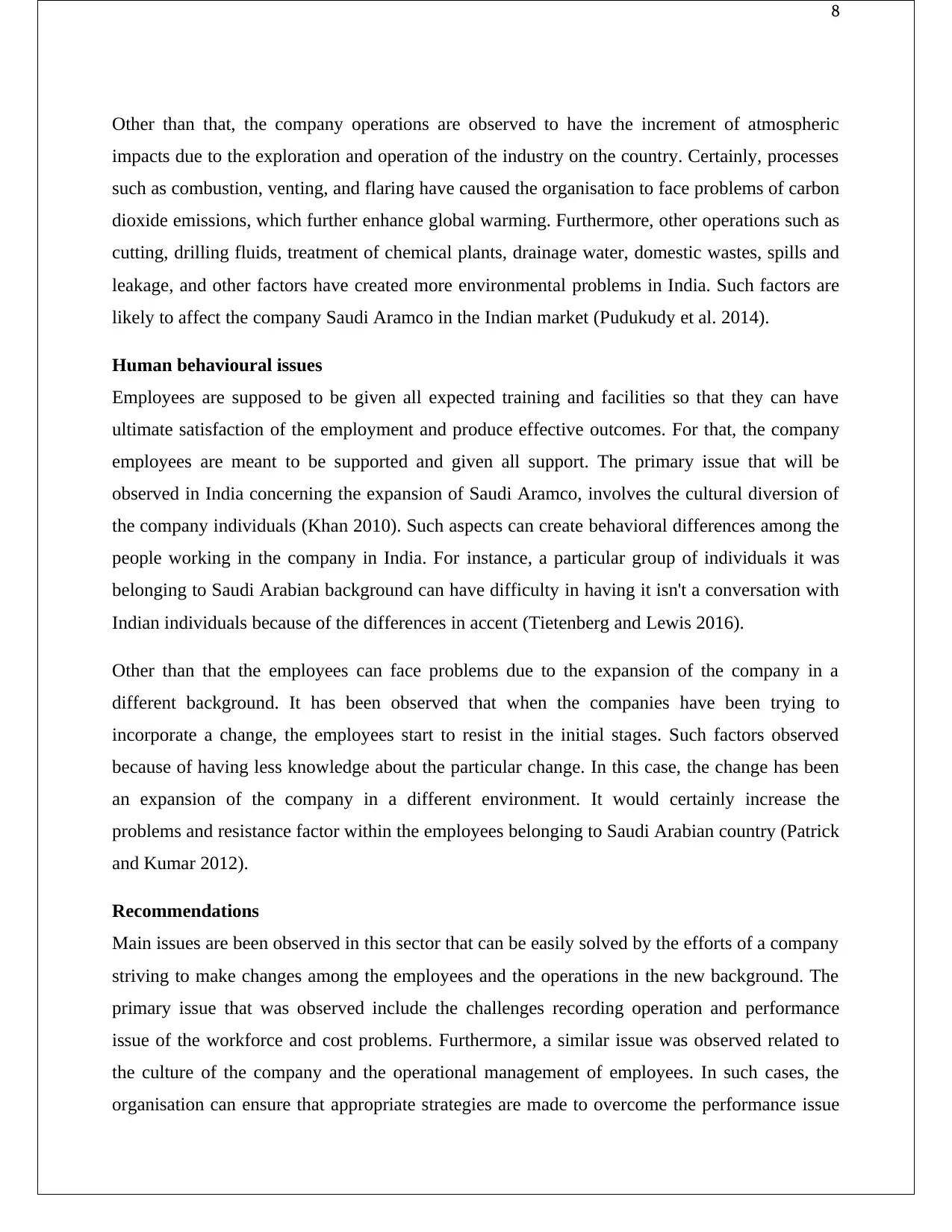
8
Other than that, the company operations are observed to have the increment of atmospheric
impacts due to the exploration and operation of the industry on the country. Certainly, processes
such as combustion, venting, and flaring have caused the organisation to face problems of carbon
dioxide emissions, which further enhance global warming. Furthermore, other operations such as
cutting, drilling fluids, treatment of chemical plants, drainage water, domestic wastes, spills and
leakage, and other factors have created more environmental problems in India. Such factors are
likely to affect the company Saudi Aramco in the Indian market (Pudukudy et al. 2014).
Human behavioural issues
Employees are supposed to be given all expected training and facilities so that they can have
ultimate satisfaction of the employment and produce effective outcomes. For that, the company
employees are meant to be supported and given all support. The primary issue that will be
observed in India concerning the expansion of Saudi Aramco, involves the cultural diversion of
the company individuals (Khan 2010). Such aspects can create behavioral differences among the
people working in the company in India. For instance, a particular group of individuals it was
belonging to Saudi Arabian background can have difficulty in having it isn't a conversation with
Indian individuals because of the differences in accent (Tietenberg and Lewis 2016).
Other than that the employees can face problems due to the expansion of the company in a
different background. It has been observed that when the companies have been trying to
incorporate a change, the employees start to resist in the initial stages. Such factors observed
because of having less knowledge about the particular change. In this case, the change has been
an expansion of the company in a different environment. It would certainly increase the
problems and resistance factor within the employees belonging to Saudi Arabian country (Patrick
and Kumar 2012).
Recommendations
Main issues are been observed in this sector that can be easily solved by the efforts of a company
striving to make changes among the employees and the operations in the new background. The
primary issue that was observed include the challenges recording operation and performance
issue of the workforce and cost problems. Furthermore, a similar issue was observed related to
the culture of the company and the operational management of employees. In such cases, the
organisation can ensure that appropriate strategies are made to overcome the performance issue
Other than that, the company operations are observed to have the increment of atmospheric
impacts due to the exploration and operation of the industry on the country. Certainly, processes
such as combustion, venting, and flaring have caused the organisation to face problems of carbon
dioxide emissions, which further enhance global warming. Furthermore, other operations such as
cutting, drilling fluids, treatment of chemical plants, drainage water, domestic wastes, spills and
leakage, and other factors have created more environmental problems in India. Such factors are
likely to affect the company Saudi Aramco in the Indian market (Pudukudy et al. 2014).
Human behavioural issues
Employees are supposed to be given all expected training and facilities so that they can have
ultimate satisfaction of the employment and produce effective outcomes. For that, the company
employees are meant to be supported and given all support. The primary issue that will be
observed in India concerning the expansion of Saudi Aramco, involves the cultural diversion of
the company individuals (Khan 2010). Such aspects can create behavioral differences among the
people working in the company in India. For instance, a particular group of individuals it was
belonging to Saudi Arabian background can have difficulty in having it isn't a conversation with
Indian individuals because of the differences in accent (Tietenberg and Lewis 2016).
Other than that the employees can face problems due to the expansion of the company in a
different background. It has been observed that when the companies have been trying to
incorporate a change, the employees start to resist in the initial stages. Such factors observed
because of having less knowledge about the particular change. In this case, the change has been
an expansion of the company in a different environment. It would certainly increase the
problems and resistance factor within the employees belonging to Saudi Arabian country (Patrick
and Kumar 2012).
Recommendations
Main issues are been observed in this sector that can be easily solved by the efforts of a company
striving to make changes among the employees and the operations in the new background. The
primary issue that was observed include the challenges recording operation and performance
issue of the workforce and cost problems. Furthermore, a similar issue was observed related to
the culture of the company and the operational management of employees. In such cases, the
organisation can ensure that appropriate strategies are made to overcome the performance issue
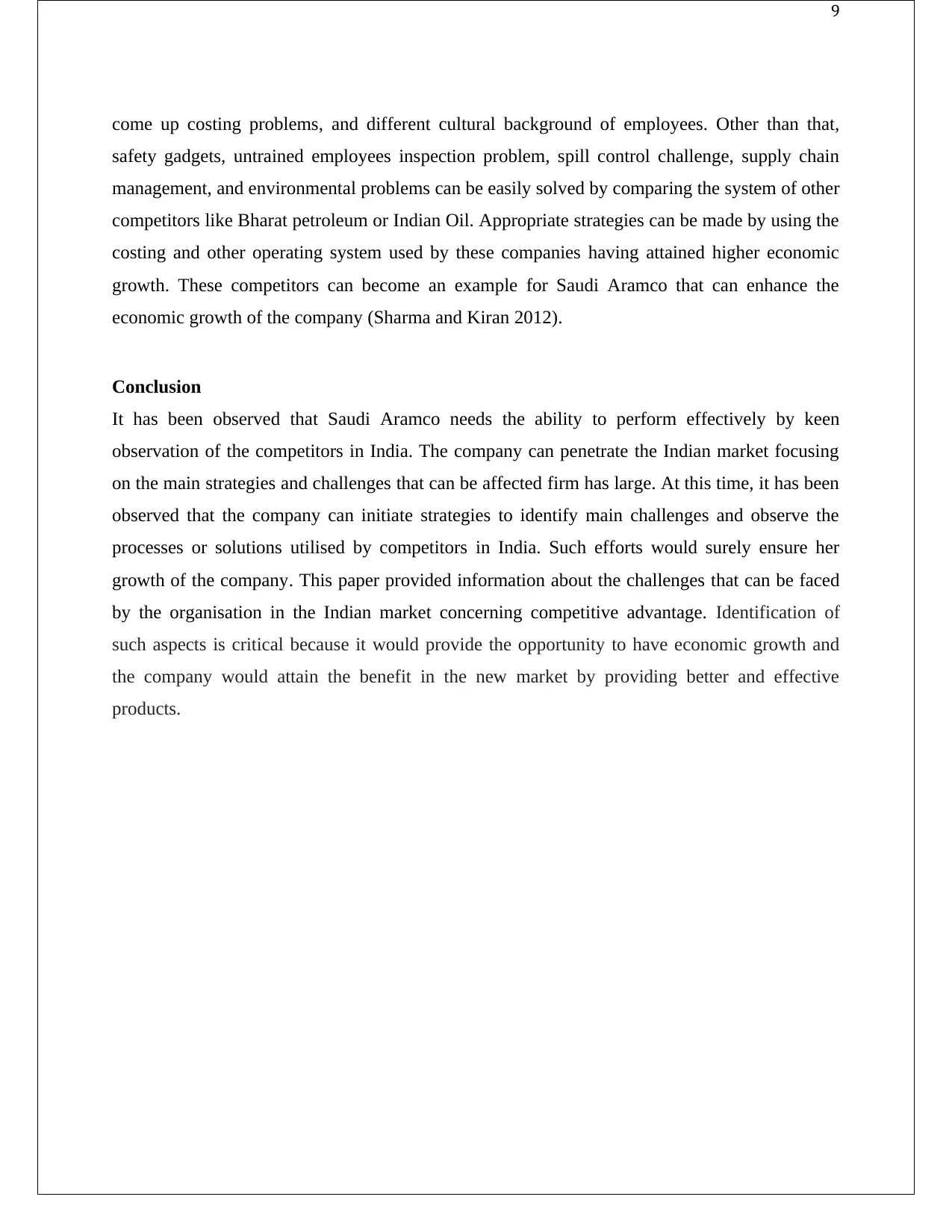
9
come up costing problems, and different cultural background of employees. Other than that,
safety gadgets, untrained employees inspection problem, spill control challenge, supply chain
management, and environmental problems can be easily solved by comparing the system of other
competitors like Bharat petroleum or Indian Oil. Appropriate strategies can be made by using the
costing and other operating system used by these companies having attained higher economic
growth. These competitors can become an example for Saudi Aramco that can enhance the
economic growth of the company (Sharma and Kiran 2012).
Conclusion
It has been observed that Saudi Aramco needs the ability to perform effectively by keen
observation of the competitors in India. The company can penetrate the Indian market focusing
on the main strategies and challenges that can be affected firm has large. At this time, it has been
observed that the company can initiate strategies to identify main challenges and observe the
processes or solutions utilised by competitors in India. Such efforts would surely ensure her
growth of the company. This paper provided information about the challenges that can be faced
by the organisation in the Indian market concerning competitive advantage. Identification of
such aspects is critical because it would provide the opportunity to have economic growth and
the company would attain the benefit in the new market by providing better and effective
products.
come up costing problems, and different cultural background of employees. Other than that,
safety gadgets, untrained employees inspection problem, spill control challenge, supply chain
management, and environmental problems can be easily solved by comparing the system of other
competitors like Bharat petroleum or Indian Oil. Appropriate strategies can be made by using the
costing and other operating system used by these companies having attained higher economic
growth. These competitors can become an example for Saudi Aramco that can enhance the
economic growth of the company (Sharma and Kiran 2012).
Conclusion
It has been observed that Saudi Aramco needs the ability to perform effectively by keen
observation of the competitors in India. The company can penetrate the Indian market focusing
on the main strategies and challenges that can be affected firm has large. At this time, it has been
observed that the company can initiate strategies to identify main challenges and observe the
processes or solutions utilised by competitors in India. Such efforts would surely ensure her
growth of the company. This paper provided information about the challenges that can be faced
by the organisation in the Indian market concerning competitive advantage. Identification of
such aspects is critical because it would provide the opportunity to have economic growth and
the company would attain the benefit in the new market by providing better and effective
products.
⊘ This is a preview!⊘
Do you want full access?
Subscribe today to unlock all pages.

Trusted by 1+ million students worldwide
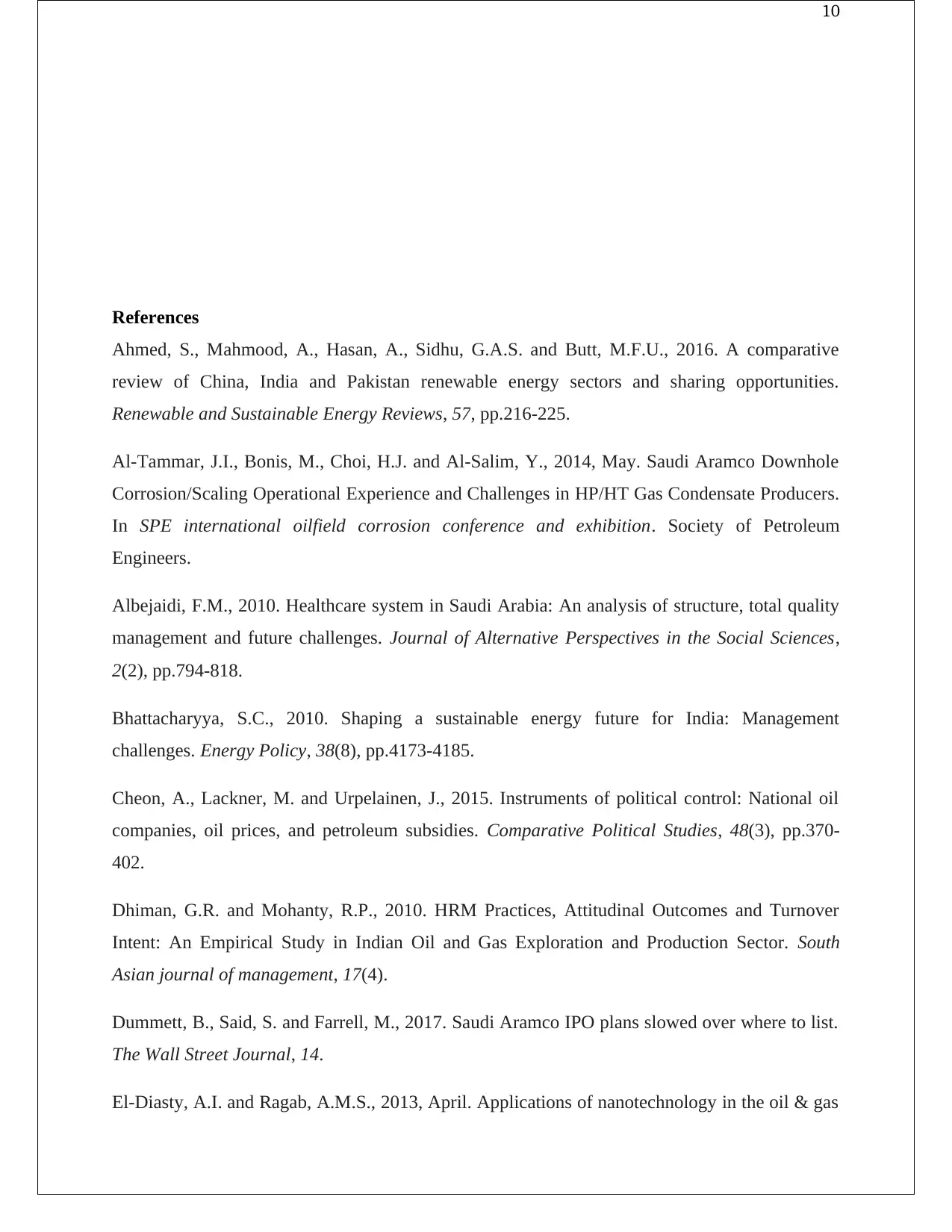
10
References
Ahmed, S., Mahmood, A., Hasan, A., Sidhu, G.A.S. and Butt, M.F.U., 2016. A comparative
review of China, India and Pakistan renewable energy sectors and sharing opportunities.
Renewable and Sustainable Energy Reviews, 57, pp.216-225.
Al-Tammar, J.I., Bonis, M., Choi, H.J. and Al-Salim, Y., 2014, May. Saudi Aramco Downhole
Corrosion/Scaling Operational Experience and Challenges in HP/HT Gas Condensate Producers.
In SPE international oilfield corrosion conference and exhibition. Society of Petroleum
Engineers.
Albejaidi, F.M., 2010. Healthcare system in Saudi Arabia: An analysis of structure, total quality
management and future challenges. Journal of Alternative Perspectives in the Social Sciences,
2(2), pp.794-818.
Bhattacharyya, S.C., 2010. Shaping a sustainable energy future for India: Management
challenges. Energy Policy, 38(8), pp.4173-4185.
Cheon, A., Lackner, M. and Urpelainen, J., 2015. Instruments of political control: National oil
companies, oil prices, and petroleum subsidies. Comparative Political Studies, 48(3), pp.370-
402.
Dhiman, G.R. and Mohanty, R.P., 2010. HRM Practices, Attitudinal Outcomes and Turnover
Intent: An Empirical Study in Indian Oil and Gas Exploration and Production Sector. South
Asian journal of management, 17(4).
Dummett, B., Said, S. and Farrell, M., 2017. Saudi Aramco IPO plans slowed over where to list.
The Wall Street Journal, 14.
El-Diasty, A.I. and Ragab, A.M.S., 2013, April. Applications of nanotechnology in the oil & gas
References
Ahmed, S., Mahmood, A., Hasan, A., Sidhu, G.A.S. and Butt, M.F.U., 2016. A comparative
review of China, India and Pakistan renewable energy sectors and sharing opportunities.
Renewable and Sustainable Energy Reviews, 57, pp.216-225.
Al-Tammar, J.I., Bonis, M., Choi, H.J. and Al-Salim, Y., 2014, May. Saudi Aramco Downhole
Corrosion/Scaling Operational Experience and Challenges in HP/HT Gas Condensate Producers.
In SPE international oilfield corrosion conference and exhibition. Society of Petroleum
Engineers.
Albejaidi, F.M., 2010. Healthcare system in Saudi Arabia: An analysis of structure, total quality
management and future challenges. Journal of Alternative Perspectives in the Social Sciences,
2(2), pp.794-818.
Bhattacharyya, S.C., 2010. Shaping a sustainable energy future for India: Management
challenges. Energy Policy, 38(8), pp.4173-4185.
Cheon, A., Lackner, M. and Urpelainen, J., 2015. Instruments of political control: National oil
companies, oil prices, and petroleum subsidies. Comparative Political Studies, 48(3), pp.370-
402.
Dhiman, G.R. and Mohanty, R.P., 2010. HRM Practices, Attitudinal Outcomes and Turnover
Intent: An Empirical Study in Indian Oil and Gas Exploration and Production Sector. South
Asian journal of management, 17(4).
Dummett, B., Said, S. and Farrell, M., 2017. Saudi Aramco IPO plans slowed over where to list.
The Wall Street Journal, 14.
El-Diasty, A.I. and Ragab, A.M.S., 2013, April. Applications of nanotechnology in the oil & gas
Paraphrase This Document
Need a fresh take? Get an instant paraphrase of this document with our AI Paraphraser
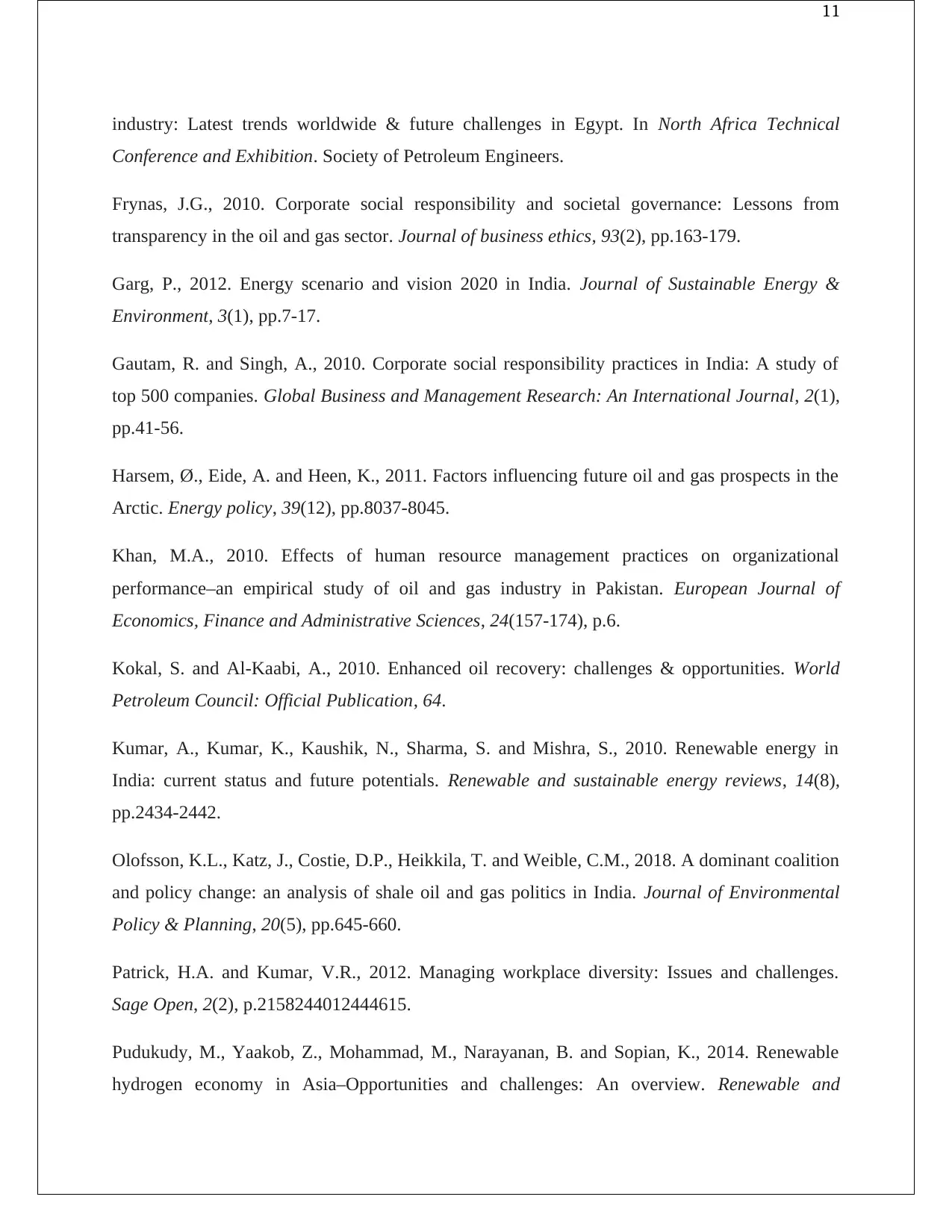
11
industry: Latest trends worldwide & future challenges in Egypt. In North Africa Technical
Conference and Exhibition. Society of Petroleum Engineers.
Frynas, J.G., 2010. Corporate social responsibility and societal governance: Lessons from
transparency in the oil and gas sector. Journal of business ethics, 93(2), pp.163-179.
Garg, P., 2012. Energy scenario and vision 2020 in India. Journal of Sustainable Energy &
Environment, 3(1), pp.7-17.
Gautam, R. and Singh, A., 2010. Corporate social responsibility practices in India: A study of
top 500 companies. Global Business and Management Research: An International Journal, 2(1),
pp.41-56.
Harsem, Ø., Eide, A. and Heen, K., 2011. Factors influencing future oil and gas prospects in the
Arctic. Energy policy, 39(12), pp.8037-8045.
Khan, M.A., 2010. Effects of human resource management practices on organizational
performance–an empirical study of oil and gas industry in Pakistan. European Journal of
Economics, Finance and Administrative Sciences, 24(157-174), p.6.
Kokal, S. and Al-Kaabi, A., 2010. Enhanced oil recovery: challenges & opportunities. World
Petroleum Council: Official Publication, 64.
Kumar, A., Kumar, K., Kaushik, N., Sharma, S. and Mishra, S., 2010. Renewable energy in
India: current status and future potentials. Renewable and sustainable energy reviews, 14(8),
pp.2434-2442.
Olofsson, K.L., Katz, J., Costie, D.P., Heikkila, T. and Weible, C.M., 2018. A dominant coalition
and policy change: an analysis of shale oil and gas politics in India. Journal of Environmental
Policy & Planning, 20(5), pp.645-660.
Patrick, H.A. and Kumar, V.R., 2012. Managing workplace diversity: Issues and challenges.
Sage Open, 2(2), p.2158244012444615.
Pudukudy, M., Yaakob, Z., Mohammad, M., Narayanan, B. and Sopian, K., 2014. Renewable
hydrogen economy in Asia–Opportunities and challenges: An overview. Renewable and
industry: Latest trends worldwide & future challenges in Egypt. In North Africa Technical
Conference and Exhibition. Society of Petroleum Engineers.
Frynas, J.G., 2010. Corporate social responsibility and societal governance: Lessons from
transparency in the oil and gas sector. Journal of business ethics, 93(2), pp.163-179.
Garg, P., 2012. Energy scenario and vision 2020 in India. Journal of Sustainable Energy &
Environment, 3(1), pp.7-17.
Gautam, R. and Singh, A., 2010. Corporate social responsibility practices in India: A study of
top 500 companies. Global Business and Management Research: An International Journal, 2(1),
pp.41-56.
Harsem, Ø., Eide, A. and Heen, K., 2011. Factors influencing future oil and gas prospects in the
Arctic. Energy policy, 39(12), pp.8037-8045.
Khan, M.A., 2010. Effects of human resource management practices on organizational
performance–an empirical study of oil and gas industry in Pakistan. European Journal of
Economics, Finance and Administrative Sciences, 24(157-174), p.6.
Kokal, S. and Al-Kaabi, A., 2010. Enhanced oil recovery: challenges & opportunities. World
Petroleum Council: Official Publication, 64.
Kumar, A., Kumar, K., Kaushik, N., Sharma, S. and Mishra, S., 2010. Renewable energy in
India: current status and future potentials. Renewable and sustainable energy reviews, 14(8),
pp.2434-2442.
Olofsson, K.L., Katz, J., Costie, D.P., Heikkila, T. and Weible, C.M., 2018. A dominant coalition
and policy change: an analysis of shale oil and gas politics in India. Journal of Environmental
Policy & Planning, 20(5), pp.645-660.
Patrick, H.A. and Kumar, V.R., 2012. Managing workplace diversity: Issues and challenges.
Sage Open, 2(2), p.2158244012444615.
Pudukudy, M., Yaakob, Z., Mohammad, M., Narayanan, B. and Sopian, K., 2014. Renewable
hydrogen economy in Asia–Opportunities and challenges: An overview. Renewable and
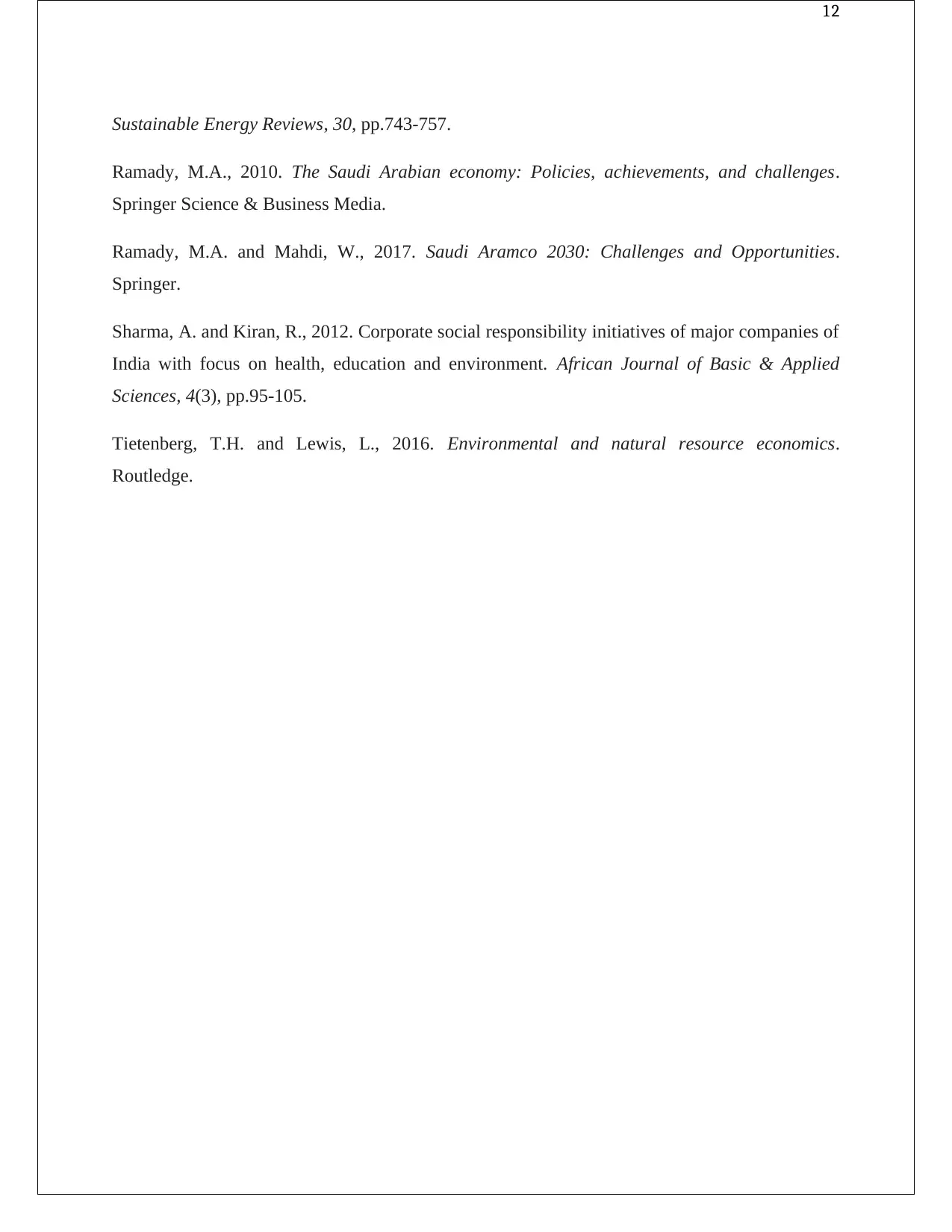
12
Sustainable Energy Reviews, 30, pp.743-757.
Ramady, M.A., 2010. The Saudi Arabian economy: Policies, achievements, and challenges.
Springer Science & Business Media.
Ramady, M.A. and Mahdi, W., 2017. Saudi Aramco 2030: Challenges and Opportunities.
Springer.
Sharma, A. and Kiran, R., 2012. Corporate social responsibility initiatives of major companies of
India with focus on health, education and environment. African Journal of Basic & Applied
Sciences, 4(3), pp.95-105.
Tietenberg, T.H. and Lewis, L., 2016. Environmental and natural resource economics.
Routledge.
Sustainable Energy Reviews, 30, pp.743-757.
Ramady, M.A., 2010. The Saudi Arabian economy: Policies, achievements, and challenges.
Springer Science & Business Media.
Ramady, M.A. and Mahdi, W., 2017. Saudi Aramco 2030: Challenges and Opportunities.
Springer.
Sharma, A. and Kiran, R., 2012. Corporate social responsibility initiatives of major companies of
India with focus on health, education and environment. African Journal of Basic & Applied
Sciences, 4(3), pp.95-105.
Tietenberg, T.H. and Lewis, L., 2016. Environmental and natural resource economics.
Routledge.
⊘ This is a preview!⊘
Do you want full access?
Subscribe today to unlock all pages.

Trusted by 1+ million students worldwide
1 out of 12
Related Documents
Your All-in-One AI-Powered Toolkit for Academic Success.
+13062052269
info@desklib.com
Available 24*7 on WhatsApp / Email
![[object Object]](/_next/static/media/star-bottom.7253800d.svg)
Unlock your academic potential
Copyright © 2020–2025 A2Z Services. All Rights Reserved. Developed and managed by ZUCOL.





